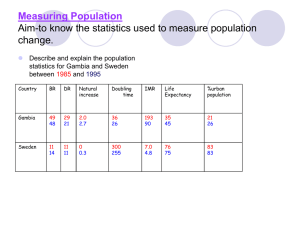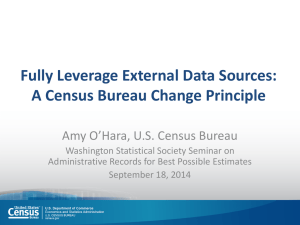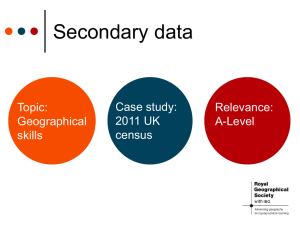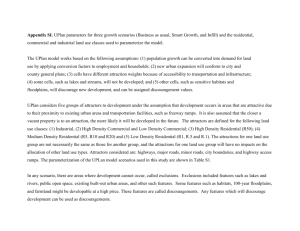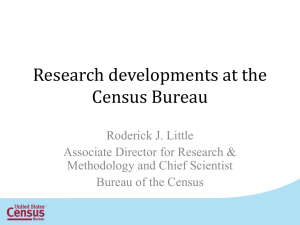Housing and Construction Data from the Census Bureau
advertisement
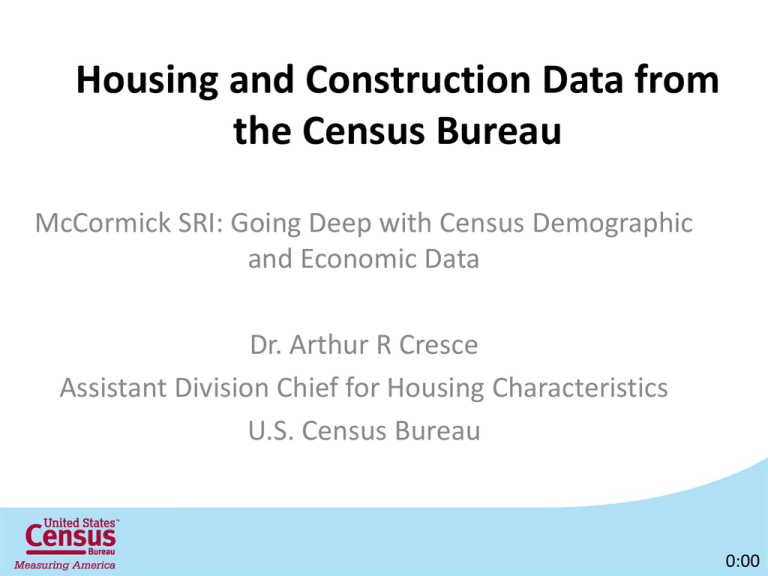
Housing and Construction Data from the Census Bureau McCormick SRI: Going Deep with Census Demographic and Economic Data Dr. Arthur R Cresce Assistant Division Chief for Housing Characteristics U.S. Census Bureau 0:00 Goals of Presentation • • • • • Key sources of housing data we produce Kinds of data these sources produce Strengths and limitations of these sources Some ideas for stories How to access these data 0:46 Key Points to Keep in Mind Using Census Data Tradeoffs among: • Geographic detail • Characteristic detail • Frequency of data collection 1:58 Key Sources of Housing Data • American Housing Survey • 2010 Census and the American Community Survey • “Other” sources of data on housing characteristics • Construction Statistics Program 2:18 About the American Housing Survey (AHS) 2:50 Inception of the AHS • A 1968 Presidential Commission on Housing found that there was not enough information on the dynamics and condition of the housing stock, especially between censuses • In 1971 Congress authorized the AHS - 1973 - first National AHS - 1974 - first Metro AHS • Sponsored by the Department of Housing and Urban Development (HUD) 2:53 AHS Today • National survey currently conducted every two years • Largest regular national housing survey in the United States - National sample - about 50,000 households with new construction added each survey year • Selected metropolitan areas surveyed every 4 to 6 years - almost 50 metro in sample at some time over last 30 years 4:00 5:20 Neighborhood quality, Neighborhood problems, Crime, Litter, Pollution, Internal and External Building Condition Household education, income and race/ethnicity Just some subject areas Mortgage financing, Rent controls & Rent subsidies Utilities and energy usage The homes people left, and why they moved here Inventory composition, Units in structure, Square footage Residential alterations and home repairs 6:25 Another Unique Feature of the AHS • The AHS has had the same panel in sample since 1985. • This allows researchers to track the same housing unit over an almost 30 year span. 10:27 11:10 11:16 11:42 12:26 Housing Characteristics in the American Community Survey (ACS) • • • • • • • • • Type of unit Tenure (own or rent) Age of structure Number of rooms Housing Value Taxes & Insurance Utilities Mortgage/Monthly Rent Etc. 13:40 Housing Characteristics in Census 2010 • Occupancy Status • Vacancy Status • Housing tenure (rented, owned) 14:27 Strengths and Limitations: 2010-ACS-AHS Census 2010 ACS AHS Minimal housing characteristics – totals, occupancy status, housing tenure, vacancy status Basic housing characteristics covering a range of housing topics Very detailed housing characteristics, including characteristics of neighborhood Very detailed geography – down to the block level 1-year - areas 65K or more 3-year - areas of 20K or more 5-year – down to block group National, regional, and some metro areas Counts and characteristics obtained at one point in time Surveys units over a 12month period Survey provides information for a point in time and also longitudinally Data collected and released once every 10 years Data collected and released every year Data collected and released every 2 years (national) and 4-6 years (specific metros) 14:51 “Other” Sources of Housing Data • Housing Vacancy Survey (Current Population Survey) • Survey of Market Absorption (SOMA) • New York City Housing and Vacancy Survey • Rental Housing Finance Survey • Survey of Income and Program Participation • Population Division Estimates Program 17:20 Ideas for News Stories About Housing Data • Availability and affordability of housing • Quality of housing and neighborhoods • Characteristics of the home and how it may be changing over time • Amenities in the home and in the community • Types of mortgages used to finance homes 20:17 2008 ACS – Single Year Data – National Level 20:40 2009 ACS – Single Year Data – National Level 21:25 The Census Bureau’s Manufacturing and Construction Division Produces a Variety of Statistics on Residential Construction • • • • • • Residential building permits Housing starts and completions New home sales Characteristics of new housing Construction spending Manufactured home placements 22:02 22:29 Two Surveys are Used to Measure New Residential Construction and Sales • Building Permits Survey (BPS) Voluntary monthly and annual mail surveys of the 20,000 local permit-issuing jurisdictions in the U.S. (Internet reporting available this summer) Tracks the number of new privately-owned structures authorized by building or zoning permits • Survey of Construction (SOC) Voluntary monthly telephone/personal interview survey of builders/owners of selected buildings (about 1 in 50 new units are sampled) Provides data on housing starts, housing completions, new home sales, prices, and characteristics of new housing units 22:55 New Residential Construction • Monthly Principal Economic Indicator Release • Data for All Units and Single-family Units • Usually released on the 12th working day of the month at 8:30am ET • Available at www.census.gov/starts •Monthly seasonally adjusted data on Permits, Starts, Completions, and Units under Construction • Annual revisions with April release each May • Historic data available 24:00 New Residential Construction Strengths (Building Permits) • Are a component of the Conference Board’s U.S. Leading Economic Index, and are a leading construction indicator • Are public records and provide timely local data: Data are released on the 18th workday of the following month for States, Metro Areas, counties, and local jurisdictions Have a large monthly sample, and annual data for all 20,000 jurisdictions are released each year on May 1st 24:35 New Residential Construction Strengths (Survey of Construction) • Includes areas where permits are not required • Response rates are high because field enumerators collect data by observation • Provides detailed annual data on characteristics of new housing – released each year on June 1st 25:01 New Residential Construction – Limitations • Data other than permits are available only for the 4 Census Regions • Confidence intervals for data other than permits are very large due to the small SOC sample size • Estimates for multifamily units often show large month-tomonth fluctuations because all units in the building are counted together: as authorized when the permit is issued as started when excavation begins for the foundation as completed when half are ready for occupancy • Single-family houses are considered completed when the finished flooring has been installed 25:45 New Residential Sales • Monthly Principal Economic Indicator Release • Commonly called “New Home Sales” • Usually released on the 17th working day of the month at 10:00am ET • Available at www.census.gov/newhomesales • Monthly seasonally adjusted data on New Houses Sold and For Sale • Median and Average Sales Prices of New Houses Sold • Annual revisions with April release each May • Data available back to 1963 27:07 New Residential Sales Strengths • Only source of national data on sales of new homes • Based on contract signings, not closings, to provide a leading indicator Data on sales of existing homes, from the National Association of Realtors (www.realtor.org) are not directly comparable because they measure closings • Response rates are high because field enumerators collect data by observation if the respondent does not participate • Price indexes of new houses sold and under construction measure inflation in home prices 27:42 New Residential Sales – Limitations • Data available only for the 4 Census Regions • Confidence intervals are very large due to the small SOC sample size • Includes only homes where the house and land are sold as a package • Includes only single-family homes and townhouses, not condominium units • Does not capture sales cancellations • Larger revisions due to high initial imputation for houses where contracts are signed before thepermit is issued and sampled 28:46 Many Sources are Used to Measure Total Construction Spending • Construction Progress Reporting Surveys (CPRS) Mail surveys of owners of sampled construction projects Data collected on: Privately-owned nonresidential construction projects Privately-owned multifamily residential buildings State and local construction projects (highways, schools, etc.) Federal construction projects (military bases, public housing, etc.) • Examples of Other Sources of Data: Data for new single-family housing are derived from the SOC Data on residential remodeling are collected in the Census Bureau’s Consumer Expenditures Survey Data on railroad construction are provided by the Surface Transportation Board Data on cable television construction are from industry trade association statistics 29:35 Construction Spending • Monthly Principal Economic Indicator Release • Commonly called “Value of Construction Put in Place (VIP)” • Usually released on the 1st working day of the month at 10:00am ET • Available at www.census.gov/constructionspending • Data available by type of construction • Monthly seasonally adjusted data available •Annual revisions with May release each July • Data available back to 1964 30:38 Construction SpendingStrengths • Estimates the total amount of money spent on allconstruction in the United States • Feeds directly into the Gross Domestic Product (GDP) • Total dollar value of all construction work: Residential and nonresidential Buildings and non-building projects Privately-financed construction Publicly-financed construction (Federal, state and local) New construction Improvements, additions, and alterations • Includes work in progress – not just completed projects 30:52 Construction Spending– Limitations • Data available for the U.S. total only • Series for some types of construction have breaks when new classifications were introduced in 1993 • Monthly data on residential remodeling are forecast because the Consumer Expenditure Survey is quarterly, and are subject to larger revisions than other series • Remodeling data include only owner-occupied properties and exclude remodeling funded by insurance claims 31:30 Manufactured Home Placements The Manufactured Housing Survey (MHS) collects data on new manufactured (mobile) homes, which are not included in the other construction data series: • Measures the number of manufactured homes placed on sites for residential use and in dealers’ inventories • Includes homes inspected at the factory by the Department of Housing and Urban Development (“HUD-code homes”) • A monthly voluntary phone survey of individual units shipped to dealers sampled from the factory inspection reports • Gathers data on prices and characteristics • Data available for the U.S. and the 4 Census Regions • Monthly data available seasonally adjusted • Available at www.census.gov/const/www/mhsindex.html 32:41 Ideas for News Stories About Construction Data • News stories tend to overstate the significance ofthe change in the latest monthly estimate, which is often not statistically significant A better story would look at trends over several months • The press may overstate the impact of weather on the numbers; bad weather rarely affects an entire region Use local building permit data to provide a local angle • The impact of government stimulus programs or budget cuts can be seen in data on public construction spending 33:17 For More Details on Census Bureau Housing and Construction Data: Census Bureau Public Information Office 301-763-3030 34:23


